

Async - Documentation. A collection of async functions for controlling the flow through a script.

Source: index.js, line 15 Methods (static) applyEach(fns, …argsopt, callbackopt) → {function} import applyEach from 'async/applyEach'; Applies the provided arguments to each function in the array, calling callback after all functions have completed. Parameters: Returns: If only the first argument, fns, is provided, it will return a function which lets you pass in the arguments as if it were a single function call. Type. GitHub - nodejitsu/module-foundry: A web service for building node.js modules that runs on Linux, SmartOS and Windows. Create a Trello Clone using Angular, Node.js, Mongo, and Express. Table of contents I.

Introduction Simple to-do lists are great for keeping track of tasks you need to accomplish. But if you’re working with a team where tasks have sub-tasks that have sub-sub-tasks and more, that’s where you especially need a project management software. Project management apps, even simple ones like Trello, can break your project down into achievable steps and give your team a more manageable workflow. WebApp to DesktopApp with Node-Webkit. This presentation is for informational purposes only.
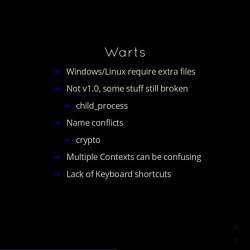
INTEL MAKES NO WARRANTIES, EXPRESS OR IMPLIED, IN THIS SUMMARY. [Intel, the Intel logo, Intel XDK and Intel XDK NEW] are trademarks of Intel Corporation in the U.S. and other countries. *Other names and brands may be claimed as the property of others. Microsoft, Windows, and the Windows logo are trademarks, or registered trademarks of Microsoft Corporation in the United States and/or other countries.
INFORMATION IN THIS DOCUMENT IS PROVIDED IN CONNECTION WITH INTEL® PRODUCTS. Linux - Running a Node Service (PM2) Linux - Running a Node Service (PM2) PM2 is a replacement for Forever which is used to run Node services (see It has a number of advantages over forever: Log aggregationAPITerminal monitoringClusteringJSON configuration Installation npm install -g pm2 Usage/Features Using the API If you want to monitor all the processes managed by PM2 as well as the status of the machine you can use the API to access the information using: $ pm2 web // This starts the api web interface then point your browser to; and you get a nice JSON info such as: Service Startup Configuration.

Keeping Your NodeJS Web App Running on Production Linux. All the following offerings that I’ve evaluated target different scenarios.
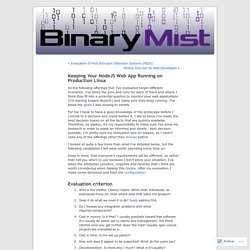
I’ve listed the pros and cons for each of them and where I think they fit into a potential solution to monitor your web applications (I’m leaning toward NodeJS) and make sure they keep running. I’ve listed the goals I was looking to satisfy. For me I have to have a good knowledge of the landscape before I commit to a decision and stand behind it. I like to know I’ve made the best decision based on all the facts that are publicly available. Therefore, as always, it’s my responsibility to make sure I’ve done my research in order to make an informed and ideally… best decision possible.
I looked at quite a few more than what I’ve detailed below, but the following candidates I felt were worth spending some time on. GitHub - tableflip/guvnor: A node process manager that isn't spanners all the way down. What are some of the most useful Node.js packages? - Quora. Painless Microsoft SQL Server with Node.js and seriate. As a developer who has spent significant time working on Microsoft's stack of technologies, I'm glad to see support for Microsoft SQL Server on the Node.js platform continue to mature.
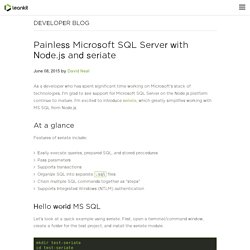
I'm excited to introduce seriate, which greatly simplifies working with MS SQL from Node.js. At a glance Features of seriate include: Easily execute queries, prepared SQL, and stored proceduresPass parametersSupports transactionsOrganize SQL into separate .sql filesChain multiple SQL commands together as "steps"Supports Integrated Windows (NTLM) authentication Hello world MS SQL. Mori. 12 Web Application Frameworks for Node.js. Yes, this is the 2nd edition to my list of Node.js frameworks, the first one was where I had put together a list of seven minimal Node.js frameworks, which later turned into one of my most visited, shared and admired posts on this blog.
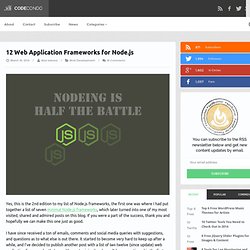
If you were a part of the success, thank you and hopefully we can make this one just as good. I have since received a ton of emails, comments and social media queries with suggestions, and questions as to what else is out there. It started to become very hard to keep up after a while, and I’ve decided to publish another post with a list of ten twelve (since update) web application frameworks, that are either not minimal, or haven’t been mentioned in the first edition. I’m gathering these up by paying attention to their usage / popularity on open-source websites like GitHub and Bitbucket, while also keeping an eye on sites like Hacker News, and Reddit.
Hello World! Remember the silly ‘Hello World!’ GitHub - tjanczuk/edge: Run .NET and Node.js code in-process on Windows, MacOS, and Linux. GitHub - adeo-proxideco/sequelize-oracle: Sequelize is an easy-to-use multi sql dialect object-relationship-mapper for node.js. It currently supports MySQL, MariaDB, SQLite and PostgreSQL. This fork add support for Oracle. GitHub - oracle/node-oracledb: Oracle Database driver for Node.js maintained by Oracle Corp.
GitHub - joeferner/node-oracle: node.js driver to connect with an oracle database. GitHub - CaffeinatedCode/knex-mssql: A knex adaptor for node-mssql. Node-oracle/INSTALL.md at master · joeferner/node-oracle. GitHub - tjanczuk/edge: Run .NET and Node.js code in-process on Windows, MacOS, and Linux. GitHub - grdunn/ga_keystone_demo: easy Keystone.js setup documentation. UglifyJS JavaScript minification. UglifyJS compression can be used as an HTTP service by sending a POST or GET request to this URL, with any of the parameters listed below either embedded in the URL, or in an application/x-www-form-urlencoded request body.

The response body will contain the compressed code in case of a successful request, or an error message when returning an error HTTP status code. code_url. 12 Web Application Frameworks for Node.js. Read Practical Keystone.js. Introduction Keystone.js is an open source Node.js based CMS and web application framework created by Jed Watson in 2013. The framework makes it very easy to build database-driven websites, applications & APIs and is built upon Express, the defacto web server for Node.js and uses Mongo DB as its storage backend. Mongo DB is a very popular and powerful document store that is capable of storing data without it being structured in a schema.
GitHub - tjanczuk/edge: Run .NET and Node.js code in-process on Windows, MacOS, and Linux. GitHub - adeo-proxideco/sequelize-oracle: Sequelize is an easy-to-use multi sql dialect object-relationship-mapper for node.js. It currently supports MySQL, MariaDB, SQLite and PostgreSQL. This fork add support for Oracle. GitHub - oracle/node-oracledb: Oracle Database driver for Node.js maintained by Oracle Corp. GitHub - joeferner/node-oracle: node.js driver to connect with an oracle database.
GitHub - CaffeinatedCode/knex-mssql: A knex adaptor for node-mssql. Knex.js - A SQL Query Builder for Javascript. GitHub - tjanczuk/edge: Run .NET and Node.js code in-process on Windows, MacOS, and Linux. Lessons from Building a Node App in Docker. Updates 2016-04-22 There was some lively discussion about this article on Hacker News. 2016-07-14 This article has been translated into Japanese!
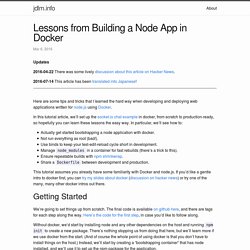
Here are some tips and tricks that I learned the hard way when developing and deploying web applications written for node.js using Docker. In this tutorial article, we’ll set up the socket.io chat example in docker, from scratch to production-ready, so hopefully you can learn these lessons the easy way. In particular, we’ll see how to: Node.js, PM2, Docker & Docker-compose DevOps – Medium. Happy new year 2016 everyone!
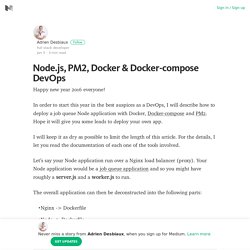
In order to start this year in the best auspices as a DevOps, I will describe how to deploy a job queue Node application with Docker, Docker-compose and PM2. Hope it will give you some leads to deploy your own app. I will keep it as dry as possible to limit the length of this article. For the details, I let you read the documentation of each one of the tools involved. Let’s say your Node application run over a Nginx load balancer (proxy). The overall application can then be deconstructed into the following parts: RabbitMQ - RabbitMQ tutorial - Remote procedure call (RPC)
Remote procedure call (RPC) (using the amqp.node client) Prerequisites This tutorial assumes RabbitMQ is installed and running on localhost on standard port (5672). In case you use a different host, port or credentials, connections settings would require adjusting. Where to get help If you're having trouble going through this tutorial you can contact us through the mailing list. In the second tutorial we learned how to use Work Queues to distribute time-consuming tasks among multiple workers.
But what if we need to run a function on a remote computer and wait for the result? In this tutorial we're going to use RabbitMQ to build an RPC system: a client and a scalable RPC server. Callback queue In general doing RPC over RabbitMQ is easy. Messaging for Node.JS made easy. This library provides a simple, socket-oriented API* for messaging in Node.JS, using RabbitMQ as a backend. *Yes, rather like ZeroMQ. See below. Uses.